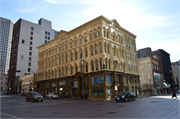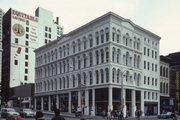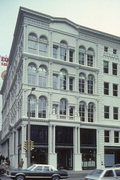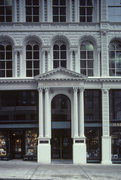Property Record
205 E WISCONSIN AVE
Architecture and History Inventory
| Historic Name: | EXCELSIOR BUILDING / Martin's Block |
|---|---|
| Other Name: | IRON BLOCK (Promised Land Co.) |
| Contributing: | |
| Reference Number: | 16292 |
| Location (Address): | 205 E WISCONSIN AVE |
|---|---|
| County: | Milwaukee |
| City: | Milwaukee |
| Township/Village: | |
| Unincorporated Community: | |
| Town: | |
| Range: | |
| Direction: | |
| Section: | |
| Quarter Section: | |
| Quarter/Quarter Section: |
| Year Built: | 1860 |
|---|---|
| Additions: | 1861 |
| Survey Date: | 1984 |
| Historic Use: | large retail building |
| Architectural Style: | Italianate |
| Structural System: | Timber Frame |
| Wall Material: | Metal |
| Architect: | George H. Johnson |
| Other Buildings On Site: | |
| Demolished?: | No |
| Demolished Date: |
| National/State Register Listing Name: | Iron Block |
|---|---|
| National Register Listing Date: | 12/27/1974 |
| State Register Listing Date: | 1/1/1989 |
| National Register Multiple Property Name: |
| Additional Information: | A 'site file' (Iron Block) exists for this property. It contains additional information such as correspondence, newspaper clippings, or historical information. It is a public record and may be viewed in person at the State Historical Society, Division of Historic Preservation. THE ONLY REMAINING BUILDING IN MILWAUKEE WITH A CAST IRON FACADE. HABS WI-251. This building is also a contributing resource in the East Side Commercial Historic District (listed 9/23/86). Milwaukee's only building with a cast iron facade. Possesses integrity of form and appearance with many of its original decorative elements extant. The Iron Block, Milwaukee's sole surviving cast-iron-fronted commercial building, recalls America's first real attempt at prefabricated architecture: the mass production of cast-iron decorative panels. In fact, between 1850 and 1870, cast iron formed many storefronts and commercial buildings. The material had much to commend it. It was strong, durable, fire-resistant, and capable of being molded into an endless variety of decorative shapes and textures. When painted, it could convincingly simulate carved stone. Most important, cast-iron cladding made in a faraway foundry could be shipped almost anywhere in the country, eliminating the need for skilled artisans, such as stonemasons, on the construction site. Cast-iron designs permitted remote American towns to erect buildings as ornate as those in the nation's largest cities. The Iron Block was a speculative venture for James Martin, an early Milwaukee settler, who ordered the cast-iron front from Daniel Badger's Architectural Iron Works in New York City and had it shipped to Milwaukee by boat. Here, Martin had the front installed on a timber and brick building skeleton. The building sports rusticated walls, round-arched windows, and Corinthian columns. Piers at the corners and between the bays are made of vermiculated blocks topped with a lion's head. Originally called the Excelsior Block after the Excelsior Lodge of Masons who occupied the top floor, the structure was extensively altered at the shop-front level, but a 1984 restoration project recreated its original appearance. Facades restored and interior rehabbed in 1984. "J.B. Martin asked the designer of his office building to use a new form of construction which he had admired in New York City. Johnson complied, and cast-iron units for the street facades, planned to resemble those on fashionable eastern store fronts, were shipped to Milwaukee by schooner from the Rochester (New York) Iron Works. When the building was completed , several Masonic lodges rented quarters in the upper stories, and Martin named the block Excelsior in honor of the lodge to which he belonged. But the public, fascinated by the unusual cast-iron construction, refused to call the building anything but Martin's Iron Block. Looking at the building's North Water Street side, one detects the location of its entrance in the days when the heaviest traffic was along this street." Pagel, Mary Ellen & Virginia Palmer for the University of Wisconsin Extension Division, Guides to Historic Milwaukee: Juneautown Walking Tour, 1965. |
|---|---|
| Bibliographic References: | THE DATE OF CONSTRUCTION AND THE NAME OF THE ARCHITECT ARE FROM THE NR NOMINATION. BUILT IN MILWAUKEE, LANDSCAPE RESEARCH, P. 77. MILWAUKEE HISTORIC BUILDINGS TOUR: JUNEAUTOWN, CITY OF MILWAUKEE DEPARTMENT OF CITY DEVELOPMENT, 1994. Tax Program. Buildings of Wisconsin manuscript. Pagel, Mary Ellen & Virginia Palmer for the University of Wisconsin Extension Division, Guides to Historic Milwaukee: Juneautown Walking Tour, 1965. |
| Wisconsin Architecture and History Inventory, State Historic Preservation Office, Wisconsin Historical Society, Madison, Wisconsin |





